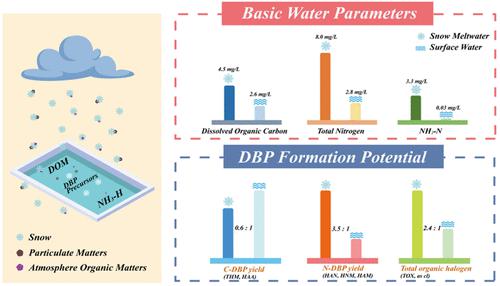当前位置:
X-MOL 学术
›
Environ. Sci. Technol.
›
论文详情
Our official English website, www.x-mol.net, welcomes your feedback! (Note: you will need to create a separate account there.)
Does Snowfall Introduce Disinfection By-product Precursors to Surface Water?
Environmental Science & Technology ( IF 11.4 ) Pub Date : 2022-10-05 , DOI: 10.1021/acs.est.2c04408 Zhenqi Du 1, 2, 3 , Shunke Ding 1, 3 , Rong Xiao 1, 3 , Chao Fang 1, 3 , Wuchang Song 2, 4 , Ruibao Jia 2, 4 , Wenhai Chu 1, 3
Environmental Science & Technology ( IF 11.4 ) Pub Date : 2022-10-05 , DOI: 10.1021/acs.est.2c04408 Zhenqi Du 1, 2, 3 , Shunke Ding 1, 3 , Rong Xiao 1, 3 , Chao Fang 1, 3 , Wuchang Song 2, 4 , Ruibao Jia 2, 4 , Wenhai Chu 1, 3
Affiliation

|
Snow with large specific surface area and strong adsorption capacity can effectively adsorb atmospheric pollutants, which could/might lead to the increase of disinfection by-product (DBP) precursors in surface water. In this study, the contents and characteristics of dissolved organic matter (DOM) in meltwater were investigated, and DBP formation and the DBP-associated cytotoxicity index during chlorination of meltwater was first explored. Overall, meltwater exhibited high nitrogen contents. Meltwater-derived DOM was mainly composed of organics with low molecular weights, low aromaticity, and high unsaturated degrees. DBP formation potentials and cytotoxicity indexes in chlorinated meltwater were positively correlated with air quality index and were significantly impacted by snowfall stages. The trihalomethane and haloacetic acid yields from meltwater were relatively low, while yields of highly cytotoxic DBPs, especially halonitromethanes (6.3–10.8 μg-HNMs/mg-DOC), were significantly higher than those of surface water (1.7 μg-HNMs/mg-DOC). Notably, unsaturated nonaromatic organic nitrates in meltwater were important precursors of halonitromethanes. The actual monitoring results showed that snowfall significant increased the haloacetaldehydes and nitrogenous DBP formation levels of surface water. Considering increased DBP formation and DBP-associated toxicity, it was demonstrated that DOM derived from snowfall in atmosphere-polluted areas could deteriorate surface water quality and pose potential risks to drinking water.
中文翻译:

降雪是否会将消毒副产品前体引入地表水?
大比表面积和强吸附能力的雪可以有效吸附大气污染物,这可能/可能导致地表水中消毒副产物(DBP)前体的增加。本研究研究了融水中溶解有机物(DOM)的含量和特征,首次探讨了融水氯化过程中DBP的形成和DBP相关的细胞毒性指数。总体而言,融水表现出高氮含量。融水衍生的DOM主要由低分子量、低芳香性和高不饱和度的有机物组成。氯化融水中 DBP 的形成潜力和细胞毒性指数与空气质量指数呈正相关,并受降雪阶段的显着影响。融水的三卤甲烷和卤乙酸产量相对较低,而高细胞毒性 DBPs,尤其是卤代硝基甲烷(6.3-10.8 μg-HNMs/mg-DOC)的产量显着高于地表水的产量(1.7 μg-HNMs/mg-医生)。值得注意的是,融水中的不饱和非芳族有机硝酸盐是卤代硝基甲烷的重要前体。实际监测结果表明,降雪显着增加了地表水中卤代乙醛和含氮DBP的形成水平。考虑到 DBP 形成增加和 DBP 相关毒性,研究表明大气污染地区降雪产生的 DOM 可能会恶化地表水质量并对饮用水构成潜在风险。8 μg-HNMs/mg-DOC),显着高于地表水(1.7 μg-HNMs/mg-DOC)。值得注意的是,融水中的不饱和非芳族有机硝酸盐是卤代硝基甲烷的重要前体。实际监测结果表明,降雪显着增加了地表水中卤代乙醛和含氮DBP的形成水平。考虑到 DBP 形成增加和 DBP 相关毒性,研究表明大气污染地区降雪产生的 DOM 可能会恶化地表水质量并对饮用水构成潜在风险。8 μg-HNMs/mg-DOC),显着高于地表水(1.7 μg-HNMs/mg-DOC)。值得注意的是,融水中的不饱和非芳族有机硝酸盐是卤代硝基甲烷的重要前体。实际监测结果表明,降雪显着增加了地表水中卤代乙醛和含氮DBP的形成水平。考虑到 DBP 形成增加和 DBP 相关毒性,研究表明大气污染地区降雪产生的 DOM 可能会恶化地表水质量并对饮用水构成潜在风险。实际监测结果表明,降雪显着增加了地表水中卤代乙醛和含氮DBP的形成水平。考虑到 DBP 形成增加和 DBP 相关毒性,研究表明大气污染地区降雪产生的 DOM 可能会恶化地表水质量并对饮用水构成潜在风险。实际监测结果表明,降雪显着增加了地表水中卤代乙醛和含氮DBP的形成水平。考虑到 DBP 形成增加和 DBP 相关毒性,研究表明大气污染地区降雪产生的 DOM 可能会恶化地表水质量并对饮用水构成潜在风险。
更新日期:2022-10-05
中文翻译:

降雪是否会将消毒副产品前体引入地表水?
大比表面积和强吸附能力的雪可以有效吸附大气污染物,这可能/可能导致地表水中消毒副产物(DBP)前体的增加。本研究研究了融水中溶解有机物(DOM)的含量和特征,首次探讨了融水氯化过程中DBP的形成和DBP相关的细胞毒性指数。总体而言,融水表现出高氮含量。融水衍生的DOM主要由低分子量、低芳香性和高不饱和度的有机物组成。氯化融水中 DBP 的形成潜力和细胞毒性指数与空气质量指数呈正相关,并受降雪阶段的显着影响。融水的三卤甲烷和卤乙酸产量相对较低,而高细胞毒性 DBPs,尤其是卤代硝基甲烷(6.3-10.8 μg-HNMs/mg-DOC)的产量显着高于地表水的产量(1.7 μg-HNMs/mg-医生)。值得注意的是,融水中的不饱和非芳族有机硝酸盐是卤代硝基甲烷的重要前体。实际监测结果表明,降雪显着增加了地表水中卤代乙醛和含氮DBP的形成水平。考虑到 DBP 形成增加和 DBP 相关毒性,研究表明大气污染地区降雪产生的 DOM 可能会恶化地表水质量并对饮用水构成潜在风险。8 μg-HNMs/mg-DOC),显着高于地表水(1.7 μg-HNMs/mg-DOC)。值得注意的是,融水中的不饱和非芳族有机硝酸盐是卤代硝基甲烷的重要前体。实际监测结果表明,降雪显着增加了地表水中卤代乙醛和含氮DBP的形成水平。考虑到 DBP 形成增加和 DBP 相关毒性,研究表明大气污染地区降雪产生的 DOM 可能会恶化地表水质量并对饮用水构成潜在风险。8 μg-HNMs/mg-DOC),显着高于地表水(1.7 μg-HNMs/mg-DOC)。值得注意的是,融水中的不饱和非芳族有机硝酸盐是卤代硝基甲烷的重要前体。实际监测结果表明,降雪显着增加了地表水中卤代乙醛和含氮DBP的形成水平。考虑到 DBP 形成增加和 DBP 相关毒性,研究表明大气污染地区降雪产生的 DOM 可能会恶化地表水质量并对饮用水构成潜在风险。实际监测结果表明,降雪显着增加了地表水中卤代乙醛和含氮DBP的形成水平。考虑到 DBP 形成增加和 DBP 相关毒性,研究表明大气污染地区降雪产生的 DOM 可能会恶化地表水质量并对饮用水构成潜在风险。实际监测结果表明,降雪显着增加了地表水中卤代乙醛和含氮DBP的形成水平。考虑到 DBP 形成增加和 DBP 相关毒性,研究表明大气污染地区降雪产生的 DOM 可能会恶化地表水质量并对饮用水构成潜在风险。



























 京公网安备 11010802027423号
京公网安备 11010802027423号